同济大学:《环境科学概论》课程教学资源(教案课件)固体废物3 Solid waste management(4)composting
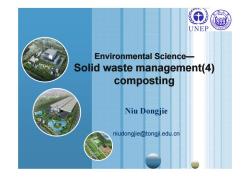
UNEP Environmental Science- Solid waste management(4) composting Niu Dongjie niudongjie@tongji.edu.cn
Environmental Science— Solid waste management(4) composting Niu Dongjie niudongjie@tongji.edu.cn
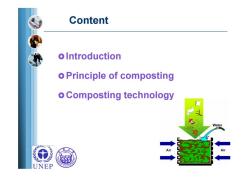
Content oIntroduction o Principle of composting o Composting technology Water UNEP
Content Introduction Principle of composting Composting technology
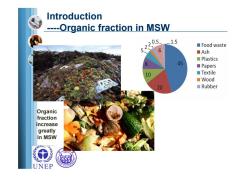
Introduction ----Organic fraction in MSW 0.5 1.5 ■Food waste 51 Ash ■Plastics 8 45 ■Papers 10 ■Textile ■Wood 20 ■Rubber Organic fraction increase greatly In MSW UNEP
Introduction ----Organic fraction in MSW Organic fraction increase greatly In MSW
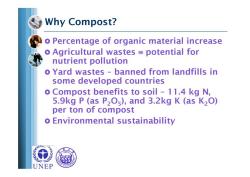
Why Compost? o Percentage of organic material increase o Agricultural wastes potential for nutrient pollution o Yard wastes-banned from landfills in some developed countries o Compost benefits to soil -11.4 kg N, 5.9kg P(as P2Os),and 3.2kg K (as K2O) per ton of compost o Environmental sustainability UNEP
Why Compost? Percentage of organic material increase Agricultural wastes potential for nutrient pollution Yard wastes – banned from landfills in some developed countries Compost benefits to soil – 11.4 kg N, 5.9kg P (as P 2 O 5), and 3.2kg K (as K 2O) per ton of compost Environmental sustainability
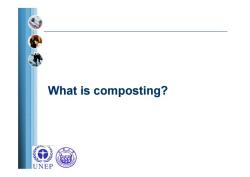
What is composting? UNEP
What is composting?
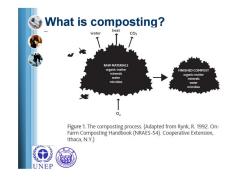
What is composting? heat water C02 RAW MATERIALS organic matter FINISHED COMPOST minerals organic matter water minerals microbes water microbes 0 Figure 1.The composting process.(Adapted from Rynk,R.1992.On- Farm Composting Handbook(NRAES-54).Cooperative Extension, Ithaca,N.Y.) UNEP
What is composting?
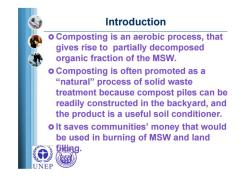
Introduction o Composting is an aerobic process,that gives rise to partially decomposed organic fraction of the MSW. o Composting is often promoted as a "natural"process of solid waste treatment because compost piles can be readily constructed in the backyard,and the product is a useful soil conditioner. o It saves communities'money that would be used in burning of MSW and land 趣g UNEP
Introduction Composting is an aerobic process, that gives rise to partially decomposed organic fraction of the MSW. Composting is often promoted as a “natural” process of solid waste treatment because compost piles can be readily constructed in the backyard, and the product is a useful soil conditioner. It saves communities’ money that would be used in burning of MSW and land filling

PRINCIPLES OF COMPOSTING UNEP
PRINCIPLES OF COMPOSTING
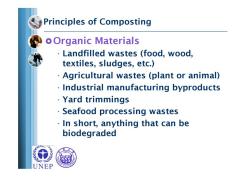
Principles of Composting o Organic Materials Landfilled wastes (food,wood, textiles,sludges,etc.) Agricultural wastes (plant or animal) Industrial manufacturing byproducts Yard trimmings Seafood processing wastes In short,anything that can be biodegraded UNEP
Principles of Composting Organic Materials • Landfilled wastes (food, wood, textiles, sludges, etc.) • Agricultural wastes (plant or animal) • Industrial manufacturing byproducts •Yard trimmings • Seafood processing wastes • In short, anything that can be biodegraded
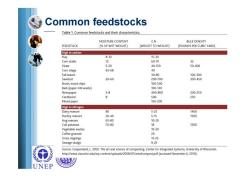
Common feedstocks Table 1.Common feedstocks and their characteristics. MOISTURE CONTENT CN BULK DENSITY FEEDSTOCK (OF WET WEIGHT) (WEIGHT TO WEIGHT) (POUNDS PER CUBIC YARD) High in carbon Hay 8-10 15-30 Corn stalks 12 60-70 Straw 520 40-150 50-400 Com silage 65-68 40 Fall leaves 30-80 100-300 Sawdust 20-60 200-700 350-450 Brush,wood chips 100-500 Bark(paper mill waste) 100-130 Newspaper 3-8 400-800 200-250 Cardboard 8 500 250 Mixed paper 150-200 High in nitrogen Dairy manure 80 5-25 1400 Poultry manure 20-40 515 1500 Hog manure 65-80 10-20 Cull potatoes 70-80 18 1500 Vegetable wastes 10-20 Coffee grounds 20 Grass clippings 15-25 Sewage sludge 9-25 Source:Cooperband,L 2002.The art and science of composting.Center for Integrated Systems,University of Wisconsin. http://www.cias.wisc.edu/wp-content/uploads/2008/07/artofcompost.pdf(accessed November 6,2010). UNEP
Common feedstocks
按次数下载不扣除下载券;
注册用户24小时内重复下载只扣除一次;
顺序:VIP每日次数-->可用次数-->下载券;
- 同济大学:《环境科学概论》课程教学资源(教案课件)固体废物2 Solid Waste Management(3)Incineration.pdf
- 同济大学:《环境科学概论》课程教学资源(教案课件)Part 2 Water Resources and Treatment Topic 2 Water pollution 水污染.pdf
- 同济大学:《环境科学概论》课程教学资源(教案课件)Part 2 Water Resources and Treatment Topic 3 Water and wastewater treatment 水处理.pdf
- 同济大学:《环境科学概论》课程教学资源(教案课件)固体废物1 Solid Waste Management(2)landfilling.pdf
- 同济大学:《环境科学概论》课程教学资源(教案课件)Part 2 Water Resources and Treatment Topic 1 Water resources 水资源.pdf
- 同济大学:《环境科学概论》课程教学资源(教案课件)来自水的挑战 Water Challenges in China.pdf
- 同济大学:《环境科学概论》课程教学资源(教案课件)概论 Environmental Science(负责人:李风亭).pdf
- 《环境科学概论》课程教学资源(文献资料)UNEP and UN-HABITAT——GREEN HILLS, BLUE CITIES AN ECOSYSTEMS APPROACH TO WATER RESOURCES MANAGEMENT FOR AFRICAN CITIES.pdf
- 《环境科学概论》课程教学资源(文献资料)Growing greenhouse gas emissions due to meat production.pdf
- 《水污染控制工程》课程教学资源(书籍资料)水污染治理先进技术汇编(科学技术部,2011年8月).pdf
- 广东海洋大学:环境资源系《遥感与地理信息系统》课程教学大纲.doc
- 广东海洋大学:环境资源系《生产布局原理》课程教学大纲.doc
- 广东海洋大学:环境资源系《环境质量评价》课程教学大纲.doc
- 广东海洋大学:环境资源系《环境生物学》课程教学大纲.doc
- 广东海洋大学:环境资源系《环境工程学》课程教学大纲.doc
- 广东海洋大学:环境资源系《环境土壤学》课程教学大纲.doc
- 广东海洋大学:环境资源系《测量学》课程教学大纲.doc
- 广东海洋大学:环境资源系《水土保持学》课程教学大纲.doc
- 广东海洋大学:环境资源系《植物营养学》课程教学大纲.doc
- 广东海洋大学:环境资源系《房地产开发与经营管理》课程教学大纲.doc
- 同济大学:《环境科学概论》课程教学资源(教案课件)大气 Fundamentals of Air Pollution Meteorology.pdf
- 同济大学:《环境科学概论》课程教学资源(教案课件)大气污染 Air and Air Pollution.pdf
- 中国人民大学:《环境管理体制分析》课程教学资源(教学大纲)Analysis of Environment Administration system.pdf
- 《环境管理体制分析》课程教学资源(文献资料)2011-2015年我国31个省能源使用情况数据统计.pdf
- 《环境管理体制分析》课程教学资源(文献资料)2012-2015年我国31个省用水情况数据统计.pdf
- 《环境管理体制分析》课程教学资源(文献资料)我们怎样喝到好水?.pdf
- 《环境管理体制分析》课程教学资源(文献资料)环境保护相关法律汇编.pdf
- 《环境管理体制分析》课程教学资源(文献资料)2011-2015年全国31个省SO2和COD排放数据(课程使用).pdf
- 《环境管理体制分析》课程教学资源(文献资料)生态文明体制改革总体方案.pdf
- 《环境管理体制分析》课程教学资源(文献资料)新形势下改革和加强中国环境保护管理体制的思考.pdf
- 《环境管理体制分析》课程教学资源(文献资料)基于GDP的中国资源环境基尼系数分析.pdf
- 《环境管理体制分析》课程教学资源(文献资料)论绿色发展理念下环境执法垂直管理体制的改革与构建.pdf
- 《环境管理体制分析》课程教学资源(文献资料)中国环境管理体制改革的回顾与反思.pdf
- 《环境管理体制分析》课程教学资源(文献资料)美国环境管理体制对中国的启示 Enlightenment of US environmental management system to China.pdf
- 《环境管理体制分析》课程教学资源(文献资料)我国环境管理体制改革思路探析.pdf
- 《环境管理体制分析》课程教学资源(文献资料)全国生态保护“十三五”规划纲要(2016年10月).pdf
- 山西师范大学:《生态学》课程教学大纲.pdf
- 上海交通大学:《环境工程学》课程教学大纲 Environmental Engineering.pdf
- 北方工业大学:环境设计《公共空间设计》课程教学大纲.pdf
- 北方工业大学:环境设计《居住空间设计》课程教学大纲.pdf
